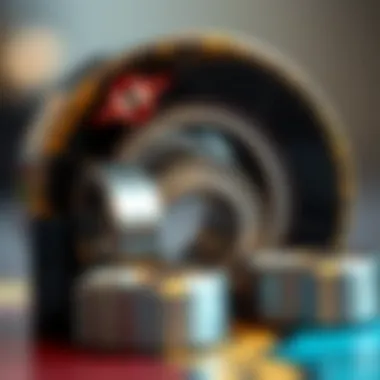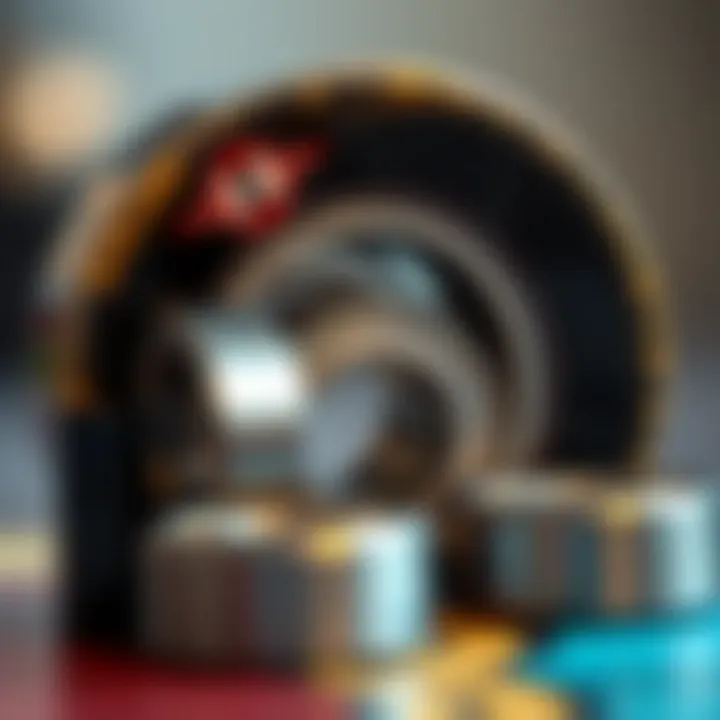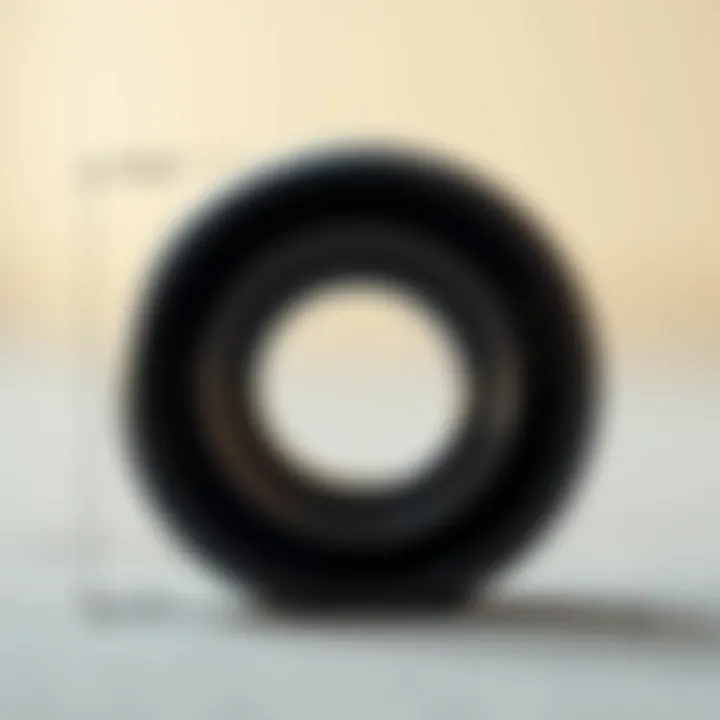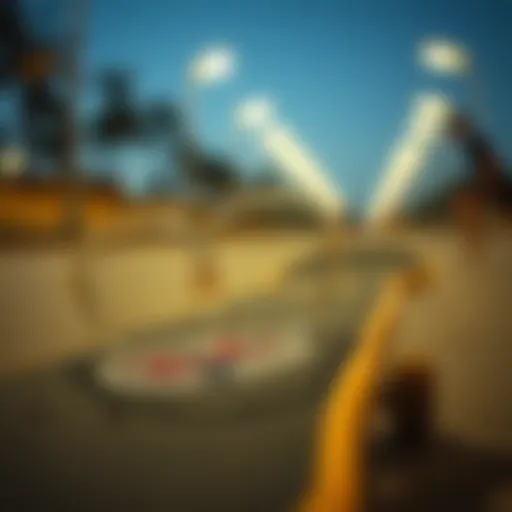Skateboard Bearing Sizes Explained: A Full Guide


Intro
In the world of skateboarding, the tiniest details can have a huge impact on performance. Just think about it: you might have a slick deck, high-quality trucks, and top-notch wheels, but if your bearings aren’t up to snuff, you might as well be skating on old cardboard. This guide dives into the often-overlooked aspect of skateboarding—bearings, focusing specifically on their sizes and how they influence your ride.
Understanding skateboard bearing sizes is essential for both seasoned riders and newbies eager to carve their names into pavement. These little metal rings might seem trivial, but they play a pivotal role in the overall skateboarding experience. From speed to maneuverability, the dimensions and types affect everything.
In this guide, you’ll get a detailed look at the various bearing sizes, their compatibility with different skate setups, and how to choose the right ones. So whether you’re flying high with tricks or cruising along the boardwalk, this comprehensive overview will set you on the right path. Prepare to gain knowledge that will make your ride smoother and keep your skateboard in top shape.
Prologue to Skateboard Bearings
When it comes to skateboarding, the wheels can steal the show, but without effective skateboard bearings, the ride could be bumpy and far less enjoyable. Understanding skateboard bearings is crucial for both enthusiasts and those just stepping onto the board for the first time. They play a critical role in how smoothly a skateboard rolls and affects overall performance.
Skateboard bearings are small, circular components that allow the wheels to spin freely around the axle. The better the bearings, the less friction there is, translating into smoother rides, increased speed, and even enhanced control.
Definition and Functionality
At their core, skateboard bearings are mechanical devices that reduce friction between the wheel and the axle. Made up of an inner ring, outer ring, balls, and a cage, these components work together to facilitate motion. Think of skateboard bearings as the engine of a car—without them, movement would be slow and cumbersome.
When you put your foot down and push off, the energy you generate transfers to the wheels through the bearings. They enable a seamless rotation, which is what keeps the ride enjoyable. Without proper bearings, you might find yourself battling resistance, making it hard to maintain speed or control during tricks.
It’s essential to note that different bearings offer varied levels of performance. For example, high-quality materials, like stainless steel or ceramic, can lead to longer-lasting durability and superior speed. However, cheaper bearings might produce a lot of noise or degrade quickly under pressure, which could ruin the skating experience.
"A smooth ride is fundamentally tied to the bearings; they could very well be the difference between a joy ride and a struggle on the board."
Investing time in understanding skateboard bearings not only helps in the short run but lends itself to long-term benefits as well. Selecting the right bearings suited for your skate style or frequency of use can drastically alter your skating experience, making it an integral part of skateboarding enthusiasts’ toolkit.
The Importance of Bearing Size
Skateboard bearings play a crucial role in the performance and experience of a skateboard. The size of these bearings, while often overlooked by beginners, can significantly impact how smoothly and efficiently a skateboard rides. Understanding the importance of bearing size helps skaters make informed decisions that not only enhance their performance but also ensure safety and longevity of their equipment.
How Size Affects Performance
When it comes to skateboard performance, size truly matters. The inner diameter, outer diameter, and width of a bearing directly influence how it interacts with the wheel and axle. A common standard for skateboard bearings is 608, which has a bearing inner diameter of 8mm, an outer diameter of 22mm, and a width of 7mm.
Choosing the right size can affect:
- Spin Efficiency: Larger bearings can provide less resistance, leading to faster spins. However, they may not fit snugly in all wheel sizes.
- Load Distribution: Bearings that are too small or large for a wheel can lead to uneven weight distribution. This translates to vibrations and less precise control.
- Durability: Bearings that are too tightly fitted or overly loose can wear out quickly. Ensuring compatibility with your skateboard setup can prolong the lifespan of your bearings, which is vital for consistent riding.
Impact on Speed and Control
The relationship between bearing size and speed is where things start to get interesting. A well-sized bearing can reduce friction, allowing for greater speeds. In skater-speak, better bearings help you roll longer distances with less effort. However, it’s not just about speed. Control is an equally important factor.
- Precision: The fit of the bearing within the wheel size affects how responsive the board is to your movements. A well-fitting bearing can enhance your ability to pivot and turn.
- Overall Stability: Using the recommended bearing sizes ensures that your wheels maintain stable contact with the surface underneath. This stability translates into better control when carving, jumping, or performing tricks.
It's a balancing act. Too much emphasis on speed at the expense of control can lead to wipeouts that could put you on the sidelines. Conversely, an overly cautious setup might dampen your overall skating experience.
Common Bearing Sizes in Skateboarding


When it comes to skateboarding, the world of bearings can often feel like a tangled web. However, understanding common bearing sizes is crucial because this knowledge directly impacts a skater's performance, board compatibility, and even safety on the deck. Each bearing size serves unique purposes, catering to various styles of skating. Making the right choice can enhance your ride.
Standard Measurements
8mm
The 8mm bearing is perhaps the most prevalent size in the skateboard realm. This dimension is standard for most skateboards and provides an excellent balance of speed and control. A notable characteristic of the 8mm is its seamless fit within numerous setups, making it a top pick for both beginners and seasoned skaters alike. The plus side? The bearings are widely available and come in a vast range of materials and brands.
However, there's a catch. While 8mm bearings are great for most applications, they may not offer the same kind of speed as larger bearings, particularly during high-speed rides. Those looking for raw velocity might find this size slightly limiting. But for the average skater, they provide reliable performance without breaking the bank.
7mm
The 7mm bearing, while less common than its 8mm counterpart, holds its ground in niche skateboarding circles. It's primarily found among specific setups and is favored for its ability to enhance trick performance by allowing skaters to perform quicker maneuvers with less friction. This smaller size often translates to a lighter overall bearing, which is crucial for technical street skating.
One of the key characteristics of the 7mm bearing is its versatility. It caters particularly well to those who prioritize agility over sheer speed. Yet it’s essential to take caution; using 7mm bearings requires compatible hardware, which isn’t as widely available as the 8mm. Hence, skaters looking into this size should be prepared to shop around more extensively for suitable gear and accessories.
10mm
The 10mm bearing is the heavyweight champion of the skateboard bearing family and usually reserved for specialized applications. These bearings find their niche in longboards or setups designed for high-speed cruising down hills. The defining feature of 10mm bearings is their robustness, often crafted from durable materials to endure tougher conditions without compromising performance.
While their size might seem like a drawback for complex tricks or technical skating, users appreciate the increased stability and control they offer in a straight line. Skaters venturing into serious speed may find 10mm bearings more advantageous, but they do come with a trade-off. Their size can make them less agile, potentially posing limitations for tricks and flips that require quick changes in direction, which might be essential for street skating.
Compatibility with Different Boards
Understanding how bearing sizes match with different skateboard setups is equally critical. During the pairing process, you'll want to make sure the bearings fit snugly in your wheels, along with the correct spacers and axle sizes. Mixing different bearing sizes can lead to instability, making your skating experience less enjoyable and could even affect safety on the board. Therefore, familiarizing yourself with bearing requirements of your particular skateboard setup cannot be overstated.
"Selecting the right bearing size is a game-changer for improving your performance and stability."
For those looking to get the best out of their setup, researching the bearing compatibility with their skateboard should always be a priority. Skaters should never overlook this crucial aspect that can define their experience, from casual riding to competitive tricks.
Understanding Bearing Ratings
Navigating the world of skateboard bearings can be as murky as a swamp on a foggy night. That’s where understanding bearing ratings comes into play. These ratings serve as an essential guide to gauge the quality and performance of skateboard bearings. Knowing how to interpret these ratings can significantly impact your skating experience, enhancing speed, control, and overall performance. It’s crucial for both novices and seasoned skaters, alike.
ABEC Ratings Explained
ABEC, short for Annular Bearing Engineering Committee, is a widely referenced rating system that categorizes bearings based on the precision of their manufacturing. A higher ABEC rating generally suggests greater precision, which can translate into less friction and smoother rides. However, it’s not always a straightforward correlation to performance in skateboarding.
- ABEC-1: Basic level, decent quality but not made for heavy-duty use.
- ABEC-3: A step up in precision, often considered the entry-point for most skateboarders.
- ABEC-5: Suitable for intermediate to advanced skaters who want a good balance between speed and durability.
- ABEC-7: Designed for performance, these bearings can handle higher speeds, making them more suited for serious skaters.
- ABEC-9: High-end offerings, these bearings are built for competition-level skating, providing the ultimate in speed and agility but at a higher cost.
While these ratings can be useful, it’s important to understand that they don’t take into account factors such as materials used or the environment in which the bearings will be used. Thus, while an ABEC-5 might seem appealing, the reality is that other rating systems may provide additional useful information.
Other Rating Systems
Aside from ABEC, there are various other systems that can also be beneficial to skaters looking to make an informed decision.
- Skate Rated (SK): This is a term often used by brands like Bones. Skate Rated bearings are specifically designed for skateboarding, with features aimed at reducing friction and improving durability. They aren't tested against the ABEC standards, which means they're tailored more for practical skateboarding than just precision.
- National Precision Bearing (NP): This rating system focuses on the application rather than just the measurement precision, emphasizing over a specific scope of application—like skateboarding. It allows skaters to find bearings that not only suit their specific needs, but also offer performance tailored to various skating styles and conditions.
- Rating by Material: Some skaters choose to evaluate bearings based on the materials used—be they steel, ceramic, or plastic. This can dramatically impact performance, where for instance, ceramic bearings often provide a higher degree of durability and lower friction than their steel counterparts, albeit at a steeper price.
Understanding these diverse rating systems helps you grasp the bigger picture about skateboard bearings. It allows skaters of all levels to make more informed choices that align with their skating style, preferences, and budget.


Remember, the ultimate goal is to find bearings that enhance your personal skating experience, instead of getting caught up in numbers alone.
For further reading about bearings, you might want to check out Wikipedia or forums like Reddit. These platforms often provide insights from fellow skaters who share their experiences and recommendations.
With the insights into both ABEC and other rating systems, you're now equipped to dive deeper into what the world of bearings can offer. The next step is to explore how these ratings can influence your choice of bearings, ensuring they fit seamlessly into your own unique skating journey.
Selecting the Right Bearings for Your Skateboard
When it comes to skateboarding, precision is everything. Selecting the right bearings might seem like a trivial task, but it plays a vital role in your overall performance. Over time, you'll find that the bearings you choose can influence not just how smooth your ride is, but also your ability to control speed and execute tricks.
A well-informed choice in bearings can set you up for success whether you're cruising through the park or attempting to nail that elusive trick. There are several factors to consider: your skill level, the type of skating you'll be doing, and the materials available.
Assessing Your Skill Level
Understanding your own skill level is fundamental when selecting bearings. Beginners might prioritize affordability and durability above all. They need something that can withstand some wear and tear, as they learn and adapt their techniques. For instance, lower-grade bearings might suffice initially, serving as a reliable learning tool.
Conversely, seasoned skaters—who likely have refined skills and greater demands—might seek advanced bearings that offer the plush ride and precision needed for tricks. As you advance, consider investing in higher quality options that provide better performance through smoother rolls and less friction. Know thyself—if you're pushing limits, aim for materials and designs that match your aspirations.
Choosing Materials and Construction
When it comes down to it, the materials and construction of your bearings will significantly affect their performance. Choosing wisely can mean the difference between a smooth ride and a frustrating experience. Here are the main types of materials to consider:
Steel
Steel bearings are often the default choice. Made from carbon steel, they come with a few benefits. They are relatively inexpensive and offer decent performance, which is why they're popular among entry-level and intermediate skaters.
One of the unique features of steel bearings is their ability to absorb impact due to their durability. However, they are prone to rust and corrosion if not maintained properly, especially after exposure to moisture. Most skaters find that with regular cleaning and lubrication, steel bearings hold up pretty well, making them a practical option.
Ceramic
On the flip side, ceramic bearings are touted for their superior performance. They offer a significant edge when it comes to heat resistance and lower friction. This means they can achieve high speeds more easily and tend to last longer under rigorous conditions.
The key characteristic of ceramic is that it is lightweight — which can contribute to an overall lighter setup. However, this luxury does come with a price; they are often much more expensive than steel. Skaters serious about performance and looking to invest in quality might find ceramic to be a worthy investment.
Plastic
Lastly, there's plastic—used primarily for affordable bearings that cater to casual skaters or kids. These bearings are generally lighter and can resist corrosion. However, their performance can fall short compared to metal options. In technical terms, plastic bearings often provide a smoother, albeit slower ride. Skaters looking for something to just roll around on occasionally might find these to be perfectly adequate.
In summary, the right bearings depend not only on the materials you prefer but also on how you skate. Assessing your skill level, paired with understanding the different types of materials available, can help in making an informed decision. Remember, the right bearings can elevate your skateboarding experience, allowing for better performance, speed, and control.
Maintaining Bearings for Optimal Performance
Keeping skateboard bearings in top-notch condition is crucial for maximizing performance on a board. Just like any mechanical part, bearings endure wear and tear after repeated use. Regular maintenance ensures that your bearings remain smooth and functional, leading to an overall better riding experience. Imagine cruising down the street, the wind in your hair, free from the annoying grinding sounds of dirty or damaged bearings; that’s the goal.
Proper maintenance not only enhances speed but also prolongs the lifespan of your bearings. This section will delve into the cleaning techniques and regular practices that skateboarders should adopt to keep their bearings rolling smoothly.
Cleaning Techniques
Cleaning skateboard bearings is a fundamental aspect of maintenance that shouldn’t be overlooked. When dirt, dust, and grime build up, they can lead to increased friction, ultimately making your ride less enjoyable. Here are some effective cleaning techniques you can employ:


- Disassemble: Start by removing the bearings from your wheels. A simple two-tool process can make this easier; a skateboard tool or socket can do the trick.
- Soak and Scrub: Place your bearings in a small container filled with a solvent like isopropyl alcohol or acetone. Allow them to soak for about 15-30 minutes. Post-soak, use a toothbrush or any soft brush to gently scrub out stubborn dirt and residue.
- Dry Thoroughly: After rinsing your bearings in a clean solvent, let them air dry completely. Avoid using a tissue or cloth, as they can leave lint behind.
- Lubricate: After drying, add a few drops of skateboard-specific lubricant to each bearing. This reduces friction and enhances performance.
This can sometimes feel like an arduous task, but it's well worth the effort. A clean bearing not only rolls faster but also gives a more enjoyable ride.
Regular Maintenance Practices
Once the cleaning is done, there are regular maintenance practices that can help keep your skateboard bearings in excellent condition:
- Routine Check-ups: Make it a habit to check your bearings every month or after a heavy skating session. Listen for unusual noises like grinding or rattling.
- Re-lubricate: Depending on how often you skate, it may be necessary to reapply lubricant regularly. If you notice a decline in performance or that your bearings feel dry, it’s time for a little oil.
- Store Properly: After a session, storing your skateboard in a dry place will help prevent rust and corrosion on metal parts. Humidity and moisture are not friends to bearings.
"A little time invested in maintenance now can save you a lot of headaches down the road."
Being attentive to the needs of your skateboard bearings can greatly affect your skateboarding experience. By adopting proper cleaning techniques and routine maintenance practices, you not only enhance performance but also ensure a longer lifespan for these crucial components of your setup.
Common Questionss about Skateboard Bearing Sizes
Understanding skateboard bearing sizes comes with its fair share of questions, especially for those who are relatively new to the sport. This section aims to address some of the most common queries surrounding skateboard bearings. Getting a grip on these frequently asked questions can aid skaters in making informed choices, ensuring a smoother and more enjoyable ride.
What is the most common bearing size?
When it comes to skateboard bearings, the most prevalent size found across various setups is typically 608. This designation refers to its internal diameter of 8mm and an external diameter of 22mm. The 608 bearings are well-suited for most skateboard wheels, which often have a standard core to accommodate this size. Some might wonder why this size dominates the scene. Well, it’s quite straightforward: compatibility and availability. Skaters often gravitate towards what is commonly used, creating a reliable standard that ensures parts fit together seamlessly. In practical terms, if you are looking to replace or upgrade your bearings, sticking with 608 would be a wise move.
Can mix different bearing sizes?
Mixing different bearing sizes may seem tempting, especially if you're in a bind or trying to make use of parts from various setups. However, this approach can lead to complications. Skateboarding is all about balance and precision, and having variable sizes can disrupt this harmony. Each bearing type is designed for compatibility with a specific wheel and axle size. If you were to install, say, an 8mm bearing on one wheel and a 7mm on another, you might find yourself experiencing uneven wear and tear. Not to mention, the ride could feel clunky or disjointed. Therefore, it’s best practice to use the same size bearings across your entire skateboard to maintain an optimal performance level.
"Consistency in bearings leads to consistency in performance."
By maintaining uniformity with bearing sizes, you’re ensuring that all aspects of the setup work together smoothly, ultimately enhancing your overall skating experience.
Finale
In wrapping up this comprehensive guide, it's crucial to understand the pivotal role that skateboard bearing sizes play in the overall performance and enjoyment of riding. Selecting the appropriate bearings is not merely a matter of preference; it deeply affects how you experience each ride.
Considering factors such as bearing size, material, and maintenance can significantly enhance your skateboard's responsiveness and durability. A well-informed choice helps prevent unnecessary wear and tear and straightforwardly correlates with safety and control on the board.
Ultimately, your choice of bearings can either make or break your skating experience. When every little bit counts—whether performing tricks at the park or cruising down streets—having the right gear at your disposal is a game changer.
Bearings might seem like just a small component in the grand scheme of skateboarding, but they are foundational to performance:
- Performance: Correct bearing size contributes to speed and smooth transitions.
- Safety: Well-maintained bearings reduce the risk of failure while performing.
- Longevity: Quality bearings that are the right size keep your setup in good shape longer.
In summary, the meticulous selection and maintenance of skateboard bearings can create a substantial impact—kickboarding into that next level of your skateboarding journey isn't just about skill; it's about ensuring you’ve set up every aspect for success.
"Great gear, great skate."
As you gear up for your next session, remember that every detail matters. So choose wisely, maintain diligently, and enjoy every ride.
Summary of Key Points
- Skateboard bearing sizes are essential for performance and safety.
- The right bearings can significantly enhance speed and control.
- Regular cleaning and maintenance extend the life of your bearings.
- Assessing your skill level and board type helps in making informed choices.
- Compatibility with various setups is vital for a smooth riding experience.
For further reading on skateboard components, check out resources like Wikipedia or forums such as Reddit.
With a well-rounded understanding of skateboard bearing sizes, you should feel confident in making the best choices for your unique skating journey.















